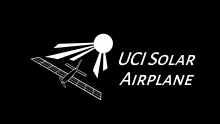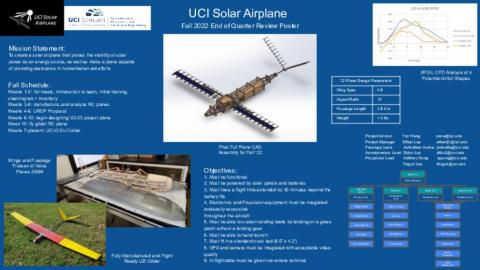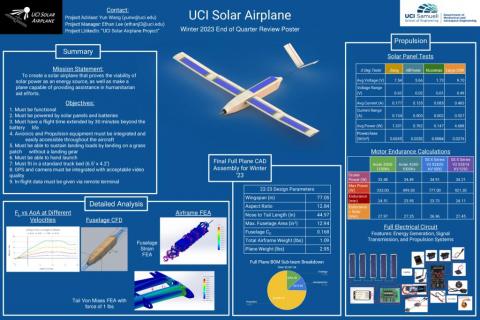UC Irvine Solar Airplane
Purpose
The purpose of the UCI Solar Airplane Project is to pioneer the path towards alternative energy implementation in everyday life. The existing effects of climate change warrant a shift in current power production in order to mitigate the inevitable effects that further global warming will cause. As a result, this project will serve as a testament to the prospect of incorporating alternative energy sources into different functions of everyday life in order to create a more sustainable future. This aircraft is aimed at providing humanitarian aid in disaster-stricken areas through the use of continuous FPV footage and a solar-supplemented power source for increased flight duration. Along with accomplishing this task, the project will simultaneously prove that incorporating alternative energy sources in preexisting operations wherever possible is a viable and necessary step in the combat against climate change.
This year's project seeks to improve upon the humanitarian aid mission of last year, and extrapolate our findings on a much larger scale. To properly overcome the effects of global warming, it is crucial to understand that the solution will not appear overnight. Investment in renewable energy sources is a task that must be undertaken consistently so that change can be noticed. By manufacturing our solar airplane, we will prove the viability of solar airplanes/drones and show that the integration of alternative energy into processes formerly reliant on fossil fuels is achievable. Along with this, our project will display how this process of renewable energy integration will only become easier in the years to follow. Our project is one of the many potential applications of renewable energy, and by continuing to apply these sustainable practices we hope to show that accomplishing small feats can help model large scale solutions to save our future.
Objectives and Design Requirements
By the end of the academic year 2022-2023, the team will have a fully functional solar airplane that has satisfied the following design requirements:
- Must be functional
- Must be powered by solar panels and batteries
- Must have a flight duration extended by 30 minutes beyond the battery life
- Electronics and Propulsion equipment must be integrated and easily accessible throughout the aircraft
- Must be able to sustain landing loads by landing on a grass patch without a landing gear
- Must be able to hand launch
- Must fit in a standard truck bed (6.5’ x 4.2’)
- GPS and camera must be integrated with acceptable video quality
- In-flight data must be given via remote terminal
With generational knowledge passed on from the previous year’s team, we aim to remedy the minor mistakes made during the design and requirements process to ensure that a functional and flying airplane will be designed and built from scratch in this year’s project. Additionally, once manufacturing and flight testing is completed, we plan to thoroughly analyze the attributes and performance of the plane. This information will be compiled into a complete, comprehensive document that speaks to this research and analysis as well as the practicality of its use in the real world.
Team Responsibilities
Fuselage Sub-team
The focus of the fuselage subteam is to research, design, and manufacture a fuselage structure which consists of a fuselage chassis and wing box structure, with the addition of conducting some miscellaneous task like monokoting (thin vinyl film) the entirety of the fuselage and other sections of the Aircraft when necessary. In order to design and manufacture the most structurally sound fuselage which will be able to withstand lift and torsion forces, research on the best fuselage type and style will be conducted, alongside research to determine the most optimal characteristics and limitations like weight restrictions, attachment methods of internal components, weight and size and internal components to ensure these components will fit freely in our fuselage, length, angle of attack the wingbox must implement, alongside much more research we need to follow in order to insure optimal flight capabilities. All of the knowledge acquired through the research completed will be used towards designing the fuselage chassis assembly, and wingbox assembly to create a co-assembly granting us the overall fuselage of our Aircraft, however as design decisions are made these decisions must be verified with the assistance of simulations programs like Finite Element Analysis and Computational Fluid Dynamics in order to insure that our design decisions have an overall positive effect on the performance of our Aircraft and not end up creating weak points in our design which are highly undesirable. In addition, most of our design decisions will be run through the rest of the team’s sub-teams in order to ensure that design characteristics and limitations carry over to eachothers designs to avoid issues. Furthermore, during the manufacturing stage the fuselage subteam will use two main building materials being balsa wood sheets and carbon fiber rods and possibly sheets if design restrictions allow it to construct the entirety of the fuselage with help of standard woodworking tools, power tools, and heavy machinery like laser cutters and CNC mills. Once the main structure is built then the skin of the Aircraft will be adhered which in our case will be monokote which is a thin vinyl film which is adhered to the building materials of the Fuselage through the assistance of heat. With the plans stated above our fuselage subteam has the appropriate roadmap to build structurally sound and aerodynamic fuselage which will grant our Aircraft optimal flight capabilities.
Aerodynamics Sub-team
The objective of the aerodynamics subteam is the design and manufacturing of the wing structure and empennage (tail), which include the control surfaces upon them which dictate flight direction. In order to optimize the design of the wings and tail, the team will evaluate certain parameters and choose the characteristics which best suit the purpose of our aircraft. The weight of the material used for construction will first be considered in order to ensure the aircraft is lightweight for efficiency. Carbon fiber and balsa wood are projected to be used for construction of the wing and tail. The team will decide on the profiles of the wing and tail by observing their aerodynamic properties; foremost, the lift-to-drag (L/D) ratio. A high L/D ratio is desired for the airplane to overcome drag while not expending excess energy to keep itself airborne. However stability of the airplane, determined by the airfoil’s shape, will also be considered because optimized stability will reduce energy consumption of the system. Team members will observe and compare these properties of multiple airfoils by using flow simulations within SolidWorks. Data analysis will provide information of the airflow and lift and drag forces produced by each airfoil at varying sizes and angles of attack. During the design of the structures, collaboration between all three sub-teams will be needed for success. Proper connection and sizing of the wing and tail is facilitated by communication with the fuselage team. Additionally, exchanging of information with the propulsion subteam will ensure smooth integration of solar panels and the appropriate accommodation of motors used to operate control surfaces. Monokote will be used as the skin of the aircraft once manufacturing of the structure is complete, and it will have to be adhered precisely and evenly to maintain stability during flight. By accomplishing the aforementioned steps, the wings will be ensured to provide the lift and stability needed for a successful flight.
Propulsion Sub-team
The propulsion sub-team is dedicated to the research and development of a robust electrical system capable of supporting all functions of our solar-powered aircraft. In order for an aircraft to be solar powered, the electronics inside the aircraft need to be optimized and meticulously calculated and calibrated to work in tandem with the limited power source of the sun. Our primary objective is to determine the amount of energy the solar panels our team selects and to use this data and apply to optimal avionics systems. Due to our wings projected to be a traditional airfoil, flexible solar panels are needed to flex around the wing for maximum efficiency while reducing drag. Along with our power source, the team will research and test different avionics such as servos and online programs such as Ardupilot to have GPS, Live-Camera feeds, and power levels. With the goal of having similar aircraft to survey disaster scenarios, having this data in real time will greatly improve a better picture for on ground personnel. Team members will have many opportunities to physically solder, wire, and conduct live tests, gaining both electrical and manufacturing experiences, which will be applied onto a R/C aircraft. The Propulsion Team is expected to work in tandem with the other two subteams to identify internal access to electronics and optimal control placements for control surfaces and electronics. One of our main priorities for this project is to maintain an optimal center of gravity for internal components. It is known that even small electronics in the aircraft either shifting or being very far from the center of gravity will greatly affect the aircraft’s performance, so an added measure of calculating the weight and positions before selection and integration is needed to ensure the most optimal center of gravity for the aircraft. With all these considerations from solar panels as an energy source, types of servos for the control surfaces, and the preliminary testing and calculations of all of our avionics will give our aircraft the best flexibility and data performance for our aircraft.
Fall Progress:
UROP Proposal: Complete
OSU Collaboration: Ongoing
Fall Design Binders:
All of the team's work has been documented in each of the three sub-team's design binders, the links of which can be found below.
Fuselage: [link to LinkedIn post with pdf]
Aerodynamics: [link to LinkedIn post with pdf]
Propulsion: [link to LinkedIn post with pdf]
Socials:
LinkedIn: https://www.linkedin.com/company/uci-solar-airplane-project/
Instagram: https://www.instagram.com/ucisolarairplane/
Contacts:
Faculty Advisor: Prof. Yun Wang
Project Manager: Ethan Lee



